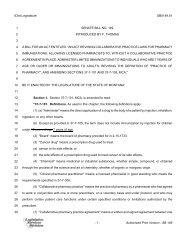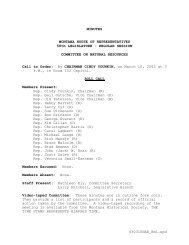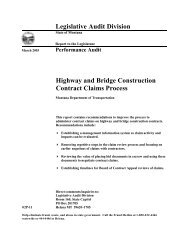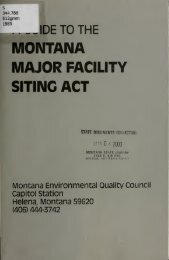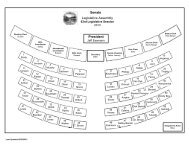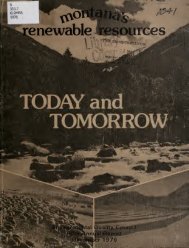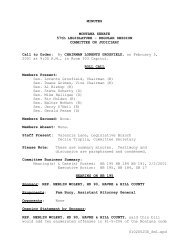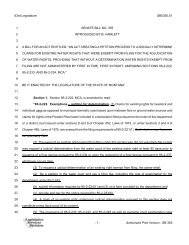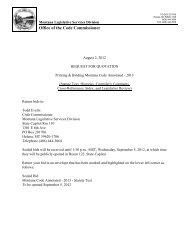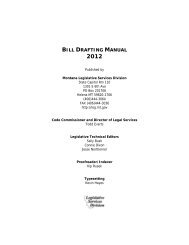Public Comment. Volume III - Montana Legislature
Public Comment. Volume III - Montana Legislature
Public Comment. Volume III - Montana Legislature
You also want an ePaper? Increase the reach of your titles
YUMPU automatically turns print PDFs into web optimized ePapers that Google loves.
The powers of the Court regarding the preliminary order ofcondemnation are set forth in Mont.<br />
Code Ann. S 70-30-206(2):<br />
(2) If the court finds and concludes from the evidence presented that the<br />
public interest requires the taking of such interest in real property and that<br />
the Plaintiff has met his burden of proof under 70-30-1 1 1, it must forthwith<br />
make and enter a preliminary condemnation order that the<br />
condemnation of the interest in real property 'may proceed in accordance<br />
with the provisions of this chapter.<br />
This statute thus determines the scope of the necessity hearing.<br />
DISPUTABLE PRESUMPTIONS<br />
<strong>Montana</strong> statutes recognize some conclusive presumptions (Mont. Code Ann. § 26-1 -60 I), and<br />
provide that all other presumptions are "disputable presumptions" which may be controverted by other<br />
evidence. Mont. Code Ann. 9 26- 1-602. The issue then is the amount ofproof required to overcome a<br />
disputable presumption.<br />
The <strong>Montana</strong> Supreme Court stated the burden of proof on aparty protesting necessity in State<br />
Highway Comm 'n v. Danielsen, 146 Mont. 539,409 P.2d 443,445 (1965). That decision stated that<br />
the property owner must, by clear and convincing proof, "show fraud, abuse of discretion, or arbitrary<br />
action" by the Department.<br />
This makes it clear that once adisputable presumption is before the Court, as it is in all necessity<br />
cases, the burden is upon the Defendants to come forward with the clear and convincing proof to overcome<br />
the presumption. This burden of production does not shift to the Landowners the burden of proof, but it<br />
does mean that they must produce proof sufficient to overcome the presumption before there is any need<br />
for the State to produce any aflknative evidence on the issue. Thus, commonly, in a necessity hearing the<br />
State will call the Court's attention to the existence of the Order and the presumption and then rest. If the<br />
Defendants produce sufficient evidence to overcome the presumption, then the State will produce rebuttal<br />
evidence.<br />
THE BURDEN OF PRODUCTION<br />
The ultimate burden of proving necessity rests with MDT, but it has the benefit of statutory affirmative<br />
proof on the issue of necessity unless and until the presumption has been overcome by evidence<br />
introduced by the Defendants. The <strong>Montana</strong> Supreme Court has addressed this issue in a number of<br />
necessity cases, expressing both the burden which the condemnee (landowner) must bear and the standard<br />
of proof which they must meet.<br />
With regard to whether the taking is necessary, this Court has consistently held that<br />
the necessity need not be absolute. Instead the test is "reasonable, requisite, and proper<br />
for the accomplishment ofthe end in view, under the particular circumstances of the case."<br />
EQC Eminent Domain Study -1 13-



